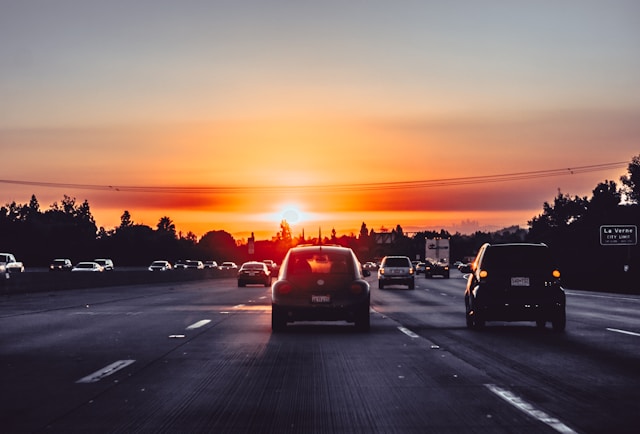5 Must-Haves for a Perfect 4th of July: Style, Food, Fun & More
5 Essential Tips for Safe Driving in Heavy Traffic

Patience, attention, and proper planning are what driving in heavy traffic requires for safety on the road. Sometimes, unexpected jams can occur from sudden stops, lane changes, and reckless driving, which will make things worse. Accidents happen when distraction, tailgating, or miscalculation of stopping distance occurs during these conditions. Heavy traffic can be stressful while driving, but safe driving habits make it safe. Here's how to drive safely.
Maintain a Safe Following Distance
Maintain a safe distance from the car ahead in heavy traffic for safety. Many drivers feel that tailgating gets them somewhere quicker, but it doubles their crash risk into the car ahead. Traffic jams can bring about abrupt stops at any time. Keep a sufficient following distance to ensure there isn't a lack of braking time. One often-recommended rule of thumb to help maintain a safe distance is the three-second rule. To use this technique, select a point on the road such as a sign or streetlight.
Count how long it takes to reach that point after the car ahead passes it. Maintain a greater following distance if fewer than three seconds. Increase the gap to five seconds in bad weather for more stops with better stopping distances. Big vehicles such as buses and trucks have larger blind spots; they also take longer to stop. If you cannot see the side mirrors of a truck, the driver can't see you either.
Thus, you must maintain more space. Moreover, stopping and starting often makes traffic worse and raises the chances of accidents. Maintain a constant speed and have enough space for maneuvering instead of always shifting between high and low speeds. Keep calm and slow down smoothly rather than get angry if another car suddenly cuts into your lane. During heavy traffic, a safe distance from other cars increases driving safety, avoids accidents, and reduces stress.
Stay Alert and Avoid Distractions
Distractions, especially in heavy traffic, are the main cause of accidents, and attention must be attentively devoted. Drivers overlook the danger of multitasking while driving, like utilizing the phone, changing music, or eating. Taking your eyes away for even one second can result in sudden braking, abrupt turns, or collision. Checking your phone for five seconds when traveling at a high speed equals driving a football field blindfolded.
While in heavy traffic, where cars halt abruptly, being a single second slower to react can lead to catastrophic accidents. To assist you in remaining focused, get your GPS, music, and other vital settings ready before you start driving. If you must place a call, utilize a hands-free device or safely pull over. Snacking while moving is a common but often not fully realized distraction.
Hot beverages, food packets, and retrieving things distract your hands from the steering wheel and affect your vehicle control. Daydreaming and tiredness impede your focus. Prolonged traffic jams leave people fatigued and tense, which slows their reaction speed. To counter this, sit erect, breathe deeply, and pay attention to your surroundings. Listen to talk radio or podcasts on the move to stay focused without letting the road be distracting. Keep checking mirrors and ahead for random car movement. Stay alert, avoid distractions to quickly react to unexpected occurrences to ensure road safety.
Use Turn Signals and Check Blind Spots
Turn signals and blind spot checks are important for road safety but are normally neglected by most people. Turn signals are important because they inform other drivers what you are going to do. This will enable them to slow down or move to another position on the road. In congested places where cars continuously change lanes, failure to use turn signals will lead to confusion, near-misses, or accidents. Use your turn signal at least three to five seconds before you turn or change lanes.
This allows other drivers in the vicinity ample time to react. Accidents often occur when drivers believe that their mirrors give them a full view of all the things surrounding them. All cars have blind spots, areas you cannot view using the side or rearview mirrors. Relying on mirrors cannot be able to notice cars around you, such as motorcycles or compact cars.
Always look over your shoulder for hidden cars before changing lanes or getting onto a new road. Trucks and buses have larger blind spots, so avoid these areas. If you are not visible to the truck driver in their mirrors, they cannot see you. Sudden changes in lanes increase accidents because drivers squeeze into small spaces, leading to hard braking and jams. Transition to a new lane if there is space, and watch for approaching lanes to prevent sudden maneuvers. Turn signals and blind spot checks prevent confusion, facilitate traffic movement, and prevent accidents in congested places.
Manage Speed and Brake Smoothly
Driving at a constant speed and stopping gently are important for safe driving in busy traffic. Drivers often speed up and then must promptly slow down. Reckless driving wastes fuel, heightens accident risks like rear-end collisions, and contributes to traffic congestion. Instead of acting on impulse, try to think ahead when you're driving. Watch how traffic is moving ahead and slowly change your speed depending on the cars in front of you.
Watch the brake lights of multiple cars ahead, not just the closest one, for a smart driving strategy. If you see brake lights ahead, start slowing down before you get there. This helps you avoid sudden stops, which means your brakes last longer and driving feels better. Maintaining a safe distance from the car ahead is crucial during heavy traffic with frequent stops.
Tailgating is risky as it limits reaction time when the front car stops suddenly. Maintain a three-second gap in bad weather or on slippery roads behind the car ahead. Also, using lower gears when going slowly can help you control your vehicle better and avoid braking too much. Changing lanes often to find a quicker way can lead to more accidents and make drivers more stressed. Choose a single lane that leads to your destination and stick with it, only changing if necessary. Driving steadily, braking gently, and avoiding sudden speed changes improve road safety, save gas, and manage traffic more effectively.
Stay Patient and Practice Defensive Driving
Staying calm and driving carefully is important when dealing with a lot of traffic. Impatience leads to aggressive driving behaviors, increasing the risk of accidents, such as tailgating, excessive honking, and sudden lane changes. Traffic jams are annoying, but driving based on feelings is dangerous for everyone on the road. Defensive driving involves staying alert to risks, anticipating reckless drivers, and remaining calm in unexpected situations.
One good way to practice safe driving is to be ready and prepared. In crowded places, some drivers might not use their turn signals, stop quickly, or weirdly change lanes. By keeping a safe distance, looking ahead on the road, and staying alert, you can respond well to these situations. If a rude driver is following you closely or trying to upset you, don't get involved. Let them go safely and keep driving carefully.
Getting angry while driving makes things more dangerous and stressful on the road. Being polite and working together can help reduce traffic jams. Respecting fellow drivers reduces delays and accidents caused by heavy traffic, benefiting all road users. Allowing merging cars space and avoiding sudden acceleration can help traffic flow smoothly. To drive safely, focus on the road and avoid distractions such as texting or adjusting controls. Paying attention to crosswalks and cyclists helps make the roads safer for everyone. Defensive driving emphasizes safety for both oneself and others by promoting calmness, awareness, and thoughtfulness in busy traffic.
Conclusion
Driving safely in busy traffic requires you to be patient, alert, and have good habits. To reduce accidents and ease traffic, maintain a safe distance, pay attention, signal turns, control speed, and drive carefully. Don't be aggressive, don't get distracted, and don't change lanes too much to help keep the roads safer.
Defensive driving is not only about keeping yourself safe, but it also helps keep other people safe. Traffic jams can be annoying, but staying calm and thinking things through can help. Using these important tips will help you handle traffic better, save fuel, and make driving safer and more enjoyable.








